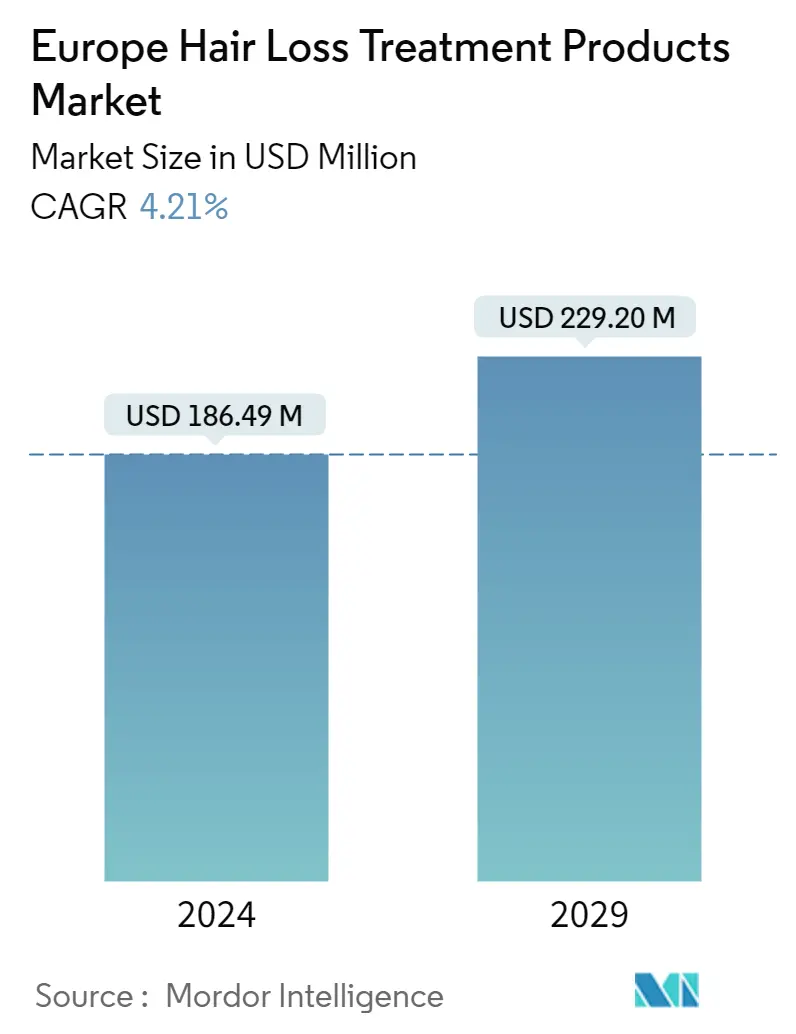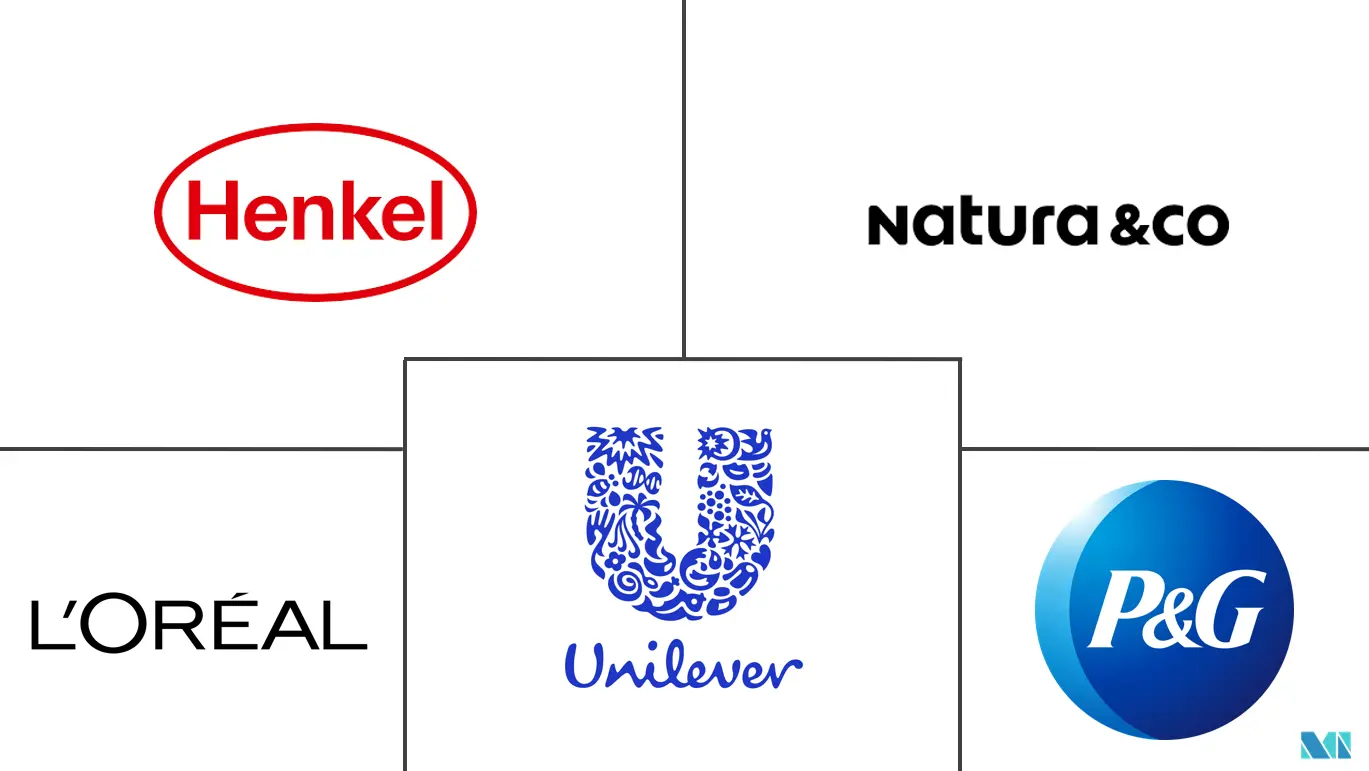Market Size of Europe Hair Loss Treatment Products Industry

| Study Period | 2019 - 2029 |
| Base Year For Estimation | 2023 |
| Market Size (2024) | USD 186.49 Million |
| Market Size (2029) | USD 229.20 Million |
| CAGR (2024 - 2029) | 4.21 % |
| Market Concentration | Medium |
Major Players
*Disclaimer: Major Players sorted in no particular order |
Europe Hair Loss Treatment Products Market Analysis
The Europe Hair Loss Treatment Products Market size is estimated at USD 186.49 million in 2024, and is expected to reach USD 229.20 million by 2029, growing at a CAGR of 4.21% during the forecast period (2024-2029).
Throughout the pandemic, millions of Europeans suffered devastating emotional stress like watching a loved one die, losing a job, working in life-threatening conditions, and bearing the brunt of violent political unrest that resulted in extreme hair loss conditions. With the growing hair fall issues, there is a surge in demand for hair loss treatment products across the world. There is an increasing awareness that hair loss treatment can help prevent hair loss and regenerate hair growth. Hence the demand is rising for hair loss treatment products globally.
The changing lifestyle coupled with the hectic schedule of consumers is leading to high-stress levels, resulting in frequent hair loss at an earlier age among the young population. This, in turn, is boosting the demand for hair loss treatment products in the region. Moreover, growing disposable income increases purchasing power, and a high emphasis on appearances is also acting as the key driver for the growth of the market. However, the presence of alternative treatment options for hair loss, such as hair transplant surgery, laser, and light-based therapies, are a few restraints for the market.
Europe Hair Loss Treatment Products Industry Segmentation
Hair-loss treatment products include all haircare products that claim to stop, control, or prevent hair loss.
The European hair loss treatment products market report analyses the recent trends, drivers, and challenges regarding the market. The market is segmented by product type, distribution channel, and geography. By product type, the market is segmented into shampoo & conditioners, oils, serums, and other product types. By distribution channel, the market is segmented into supermarkets/hypermarkets, pharmacies, specialty stores, online retail stores, and other distribution channels. By geography, the market covers Germany, the United Kingdom, France, Spain, Italy, Russia, and other geographies. For each segment, the market sizing and forecasts have been done on the basis of value in USD million.
| Product Type | |
| Shampoo & Conditioners | |
| Oils | |
| Serums | |
| Other Product Types |
| Distribution channel | |
| Supermarkets/Hypermarkets | |
| Pharmacies | |
| Specialty Stores | |
| Online Retail Stores | |
| Other Distribution Channels |
| Geography | |
| Germany | |
| United Kingdom | |
| France | |
| Spain | |
| Italy | |
| Russia | |
| Other Geographies |
Europe Hair Loss Treatment Products Market Size Summary
The Europe hair loss treatment products market is experiencing a notable expansion, driven by increasing awareness and demand for solutions to combat hair loss. The emotional and psychological impacts of the pandemic, coupled with lifestyle changes and high-stress levels, have contributed to a rise in hair loss issues among the population. This has led to a growing interest in hair loss treatment products, as consumers seek effective ways to prevent and reverse hair thinning. The market is further bolstered by rising disposable incomes and a heightened focus on personal appearance, which encourages spending on hair care solutions. Despite the availability of alternative treatments like hair transplants and laser therapies, the demand for topical and over-the-counter products remains strong, particularly in regions with high prevalence of male pattern baldness and conditions like PCOS/PCOD among women.
The competitive landscape of the European hair loss treatment products market is characterized by the presence of major players such as L'Oreal S.A., Procter & Gamble Company, Henkel AG & Co. KGaA, Natura & Co., and Unilever PLC. These companies are actively engaging in product innovation and strategic mergers and acquisitions to capture a larger market share. The introduction of natural and organic products is gaining traction, reflecting a shift in consumer preference towards safer and more sustainable options. The market's growth is also supported by prominent domestic players in countries like Germany, who are well-versed in local consumer preferences. As the market continues to evolve, companies are investing in research and development to address the increasing demand for effective hair loss treatments, ensuring they remain competitive in this dynamic industry.
Europe Hair Loss Treatment Products Market Size - Table of Contents
-
1. MARKET DYNAMICS
-
1.1 Market Drivers
-
1.2 Market Restraints
-
1.3 Porter's Five Forces Analysis
-
1.3.1 Threat of New Entrants
-
1.3.2 Bargaining Power of Buyers/Consumers
-
1.3.3 Bargaining Power of Suppliers
-
1.3.4 Threat of Substitute Products
-
1.3.5 Intensity of Competitive Rivalry
-
-
-
2. MARKET SEGMENTATION
-
2.1 Product Type
-
2.1.1 Shampoo & Conditioners
-
2.1.2 Oils
-
2.1.3 Serums
-
2.1.4 Other Product Types
-
-
2.2 Distribution channel
-
2.2.1 Supermarkets/Hypermarkets
-
2.2.2 Pharmacies
-
2.2.3 Specialty Stores
-
2.2.4 Online Retail Stores
-
2.2.5 Other Distribution Channels
-
-
2.3 Geography
-
2.3.1 Germany
-
2.3.2 United Kingdom
-
2.3.3 France
-
2.3.4 Spain
-
2.3.5 Italy
-
2.3.6 Russia
-
2.3.7 Other Geographies
-
-
Europe Hair Loss Treatment Products Market Size FAQs
How big is the Europe Hair Loss Treatment Products Market?
The Europe Hair Loss Treatment Products Market size is expected to reach USD 186.49 million in 2024 and grow at a CAGR of 4.21% to reach USD 229.20 million by 2029.
What is the current Europe Hair Loss Treatment Products Market size?
In 2024, the Europe Hair Loss Treatment Products Market size is expected to reach USD 186.49 million.

